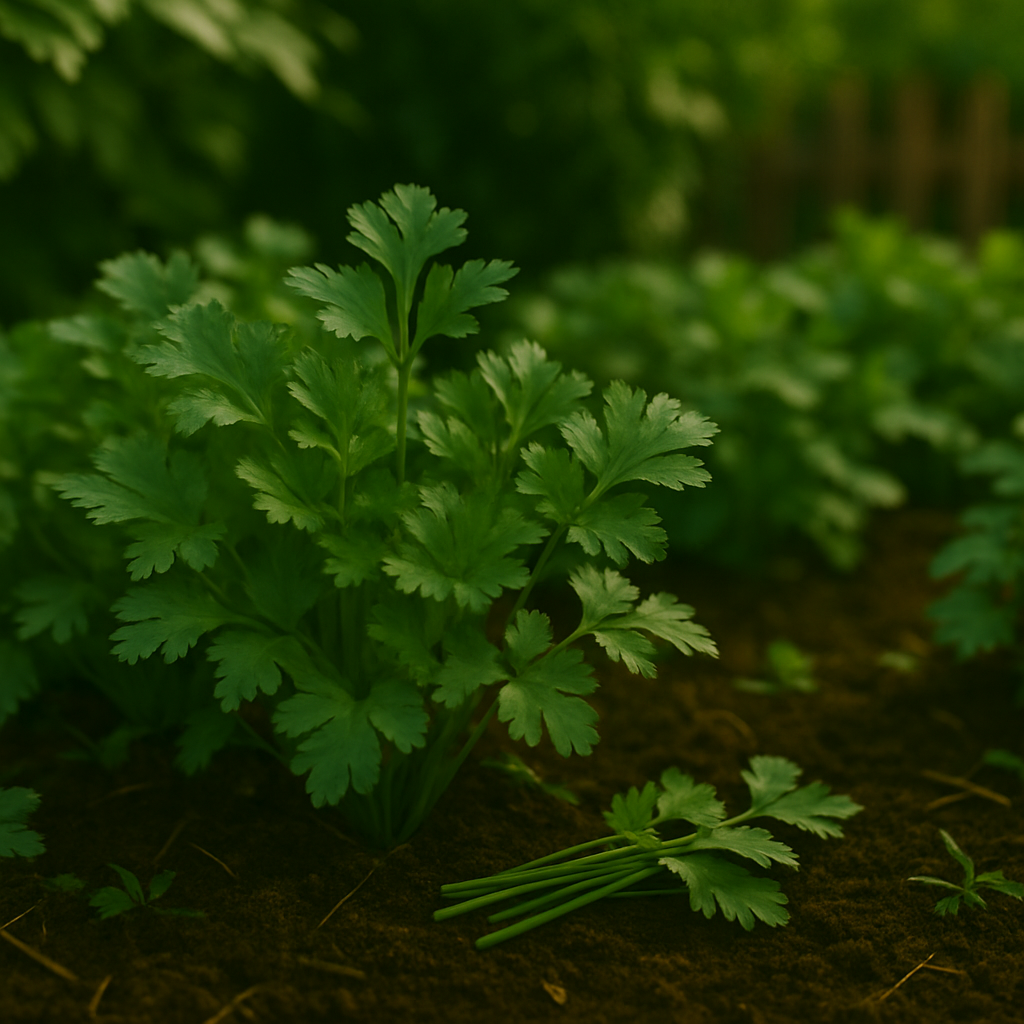Why Grow Cilantro at Home?
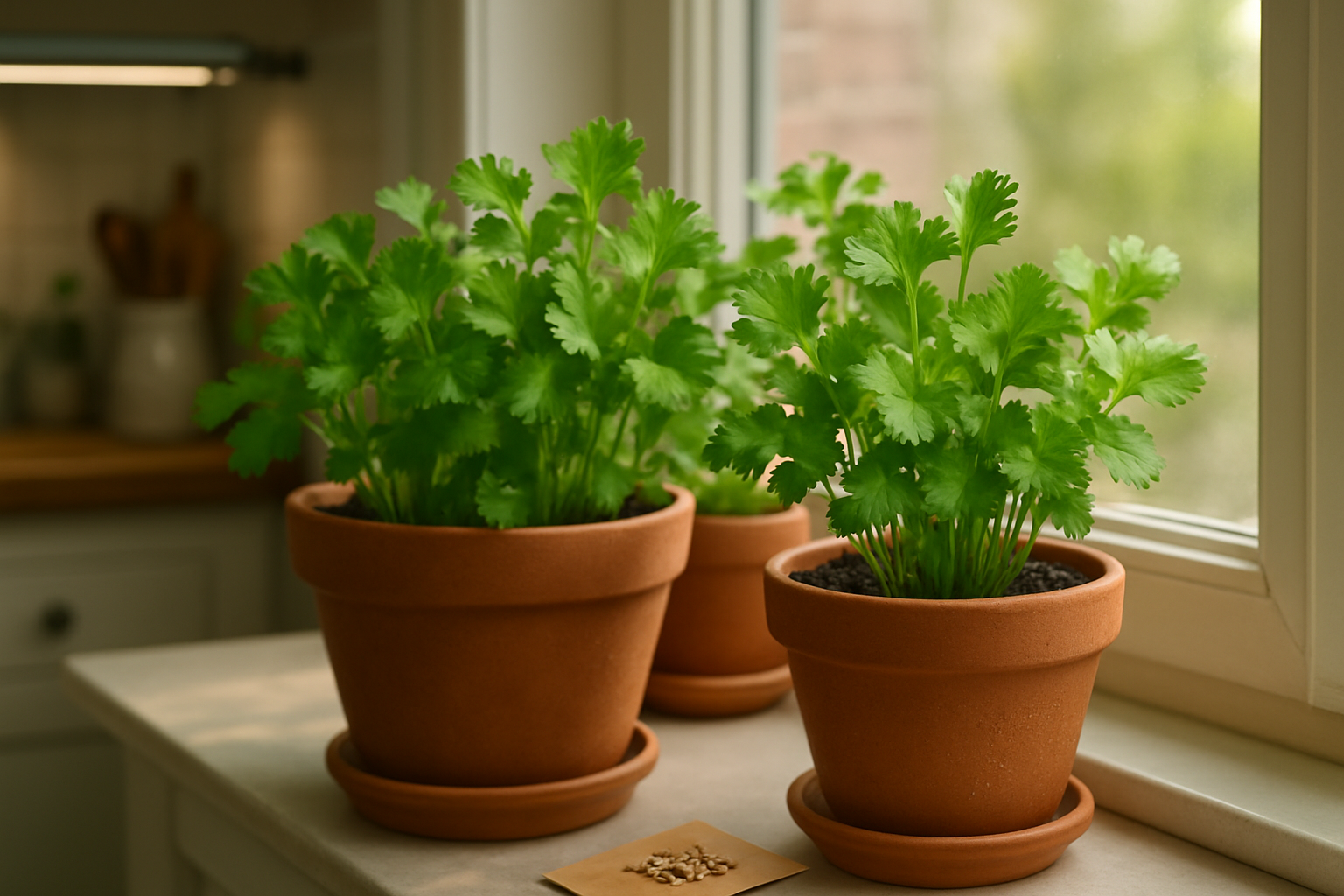
Cilantro, also known as coriander leaves, is a vibrant green herb cherished worldwide—from zesty Mexican salsas and fragrant Indian curries to tangy Thai salads. Its bright, citrusy flavor can’t be matched, making it a staple in kitchens that crave fresh, bold tastes.
Growing cilantro at home offers a handful of perks that store-bought bunches just can’t provide. For one, you get unbeatable freshness—nothing elevates a dish quite like snipping a few leaves seconds before serving. Plus, cultivating your own herbs significantly cuts grocery bills, especially if you often toss wilted cilantro that didn’t get used in time. Having a steady, all-season supply by your kitchen window or in your garden also ensures you’ll always have that essential ingredient on hand, whenever the craving strikes.
For beginners, cilantro is especially appealing since it’s more forgiving than fussier herbs like basil or rosemary. It can thrive indoors or out, needs minimal attention beyond occasional watering, and sprouts quickly—sometimes in just a week. This means you can enjoy lush, flavorful leaves with little effort, letting you focus your energy on experimenting in the kitchen.
Whether you’re dreaming of homemade guacamole or adding a pop of green to soups, starting a pot of cilantro is a simple, rewarding step toward fresher meals and a more sustainable kitchen.
When and Where to Plant Cilantro
Timing is everything when it comes to growing healthy cilantro, so choosing the right planting season is key. Cilantro thrives in cool weather, making early spring and fall the best times for planting in most temperate climates. In regions with mild winters, you can even sow cilantro in late fall for a winter harvest.
This herb bolts, or goes to seed, quickly in the heat, so avoid planting in the peak of summer—hot weather causes leaves to turn bitter and slows growth.
Deciding whether to grow cilantro indoors or outdoors depends largely on your available space and climate.
Growing Cilantro Outdoors
Outdoors, cilantro benefits from natural rainfall and airflow. Garden beds or raised planters with loose, well-drained soil allow roots to spread out. However, outdoor growing means you’re at the mercy of temperature swings and shifting sun patterns.
Growing Cilantro Indoors
Indoors, cilantro offers more control—you can use a sunny windowsill or a grow light to keep plants cool and provide the 4-6 hours of sunlight they need daily. The downside is that containers may dry out faster indoors; keep soil consistently moist but not soggy.
Choosing the Best Spot
Whether outdoors or inside, pick a spot with partial shade in hotter climates to protect against excessive afternoon sun, which can lead to early bolting. In cooler regions, a location with more direct sunlight is ideal.
- Containers should be at least 8 inches deep to allow for healthy root growth.
- Garden beds offer space for multiple plantings.
Real-world tip: If you notice your cilantro gets too much sun, simply use shade cloth or move containers during the hottest part of the day—flexibility makes it easier to keep your harvest coming longer.
Choosing the Right Variety and Preparing to Plant
When starting your cilantro journey, choosing the right variety makes a big difference—especially for beginners. Popular options like ‘Santo,’ ‘Calypso,’ and ‘Caribe’ are well-loved for their robust flavor and, most importantly, their slow-bolting characteristics. Slow-bolting types give you a longer harvest window by resisting the urge to flower (and then seed) when the weather heats up. This means you’ll get more leafy growth before your plants switch gears, which is great for home cooks who want fresh cilantro at their fingertips for as long as possible.
For most gardeners, sowing cilantro seed directly into the soil is the way to go. Cilantro has a delicate taproot that doesn’t like being disturbed, so starting in pots and transplanting can result in stunted plants. Sowing straight into the ground lets seedlings establish themselves where they’ll grow and thrive.
To prep your garden bed, pick a spot with full sun but consider afternoon shade in very hot climates to prevent premature bolting. Cilantro prefers slightly acidic to neutral soil, aiming for a pH between 6.2 and 6.8. Good drainage is key—waterlogged soil will quickly rot the roots, so if your soil is heavy, mix in some sand or fine gravel.
Enrich your bed with compost or well-rotted manure about a week before planting; this boosts fertility and helps retain just the right amount of moisture. A quick soil test, available from hardware stores or online, can give you helpful insights into your pH and nutrient levels, so you can adjust before sowing.
By choosing beginner-friendly varieties, sowing directly, and prepping your soil thoughtfully, you set yourself up for a lush, fragrant cilantro harvest even if it’s your very first try.
Step-by-Step
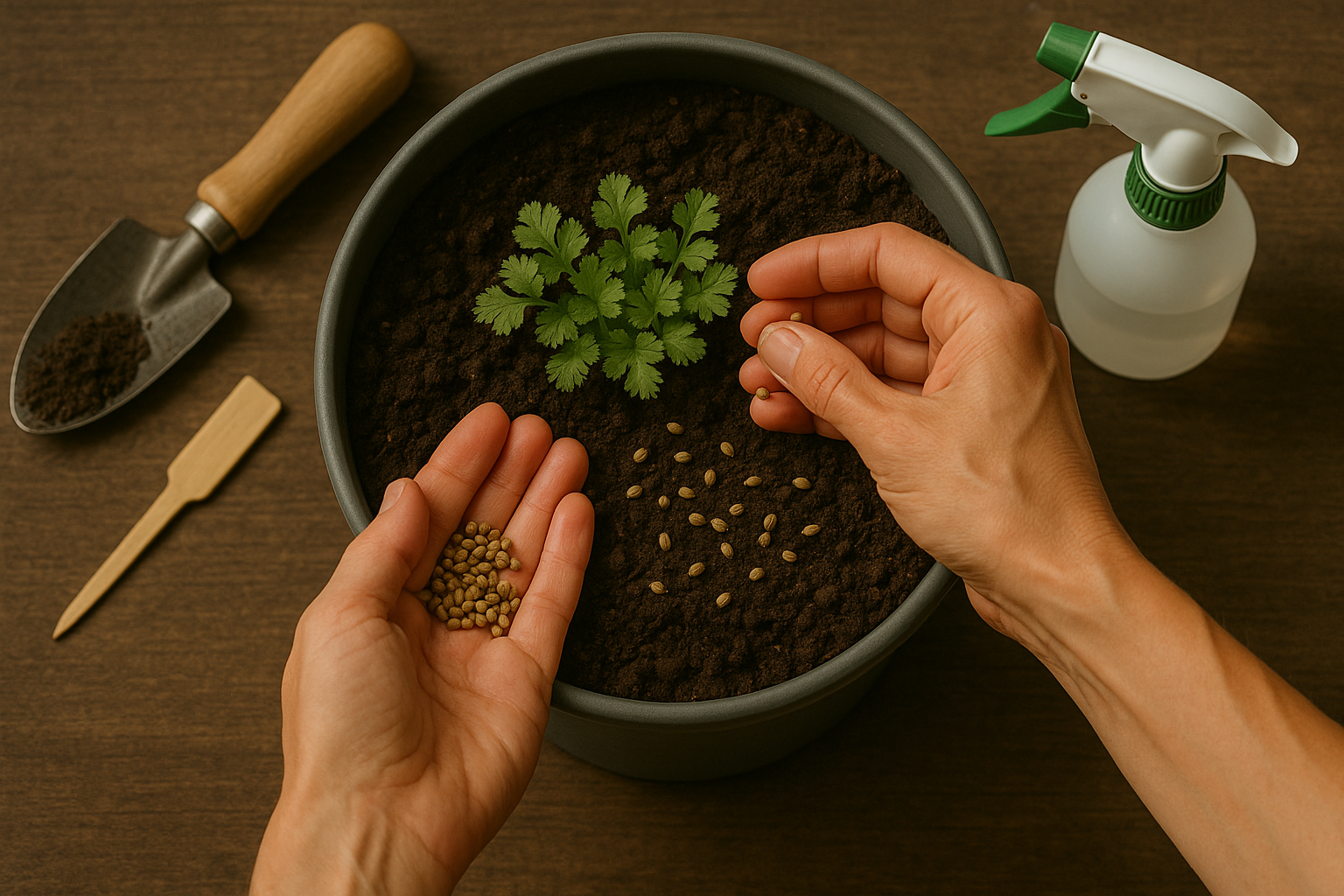
To plant cilantro seeds successfully, start by choosing a sunny spot or prepare a container at least 8 inches deep with well-drained, fertile soil. Gently scatter cilantro seeds onto the soil surface, then cover them with a thin 1/4-inch (about 0.6 cm) layer of soil—this helps the seeds stay moist without being buried too deep. Space seeds about 2 inches apart, or if sowing in rows, keep rows at least 8 inches apart to allow room for growth and airflow.
Once planted, water gently using a spray bottle or light shower. Avoid soaking the seeds, as this can lead to rot; aim to keep the soil evenly damp but never soggy. Cilantro seeds typically germinate in 7–14 days. During this phase, be patient and resist the urge to overwater, since too much moisture is the most common cause of poor germination and fungal issues.
When seedlings reach about 2 inches tall, thin them so healthy plants stand roughly 4–6 inches apart. This reduces overcrowding and promotes strong, leafy growth.
For the best results, keep the soil moist but not waterlogged, and ensure the seedlings get at least 4–6 hours of sunlight per day. If growing indoors, place pots near a bright window or use a grow light.
Watch for early-stage problems like yellowing leaves (often a sign of overwatering) or patchy sprouting (possibly due to old seeds or uneven moisture). Using fresh seeds combined with a light hand on watering helps avoid these issues. Check soil moisture daily, especially in warm weather, and mulch lightly with straw or peat moss to keep soil temperature even.
With these steps, your cilantro seedlings will have the best start and reward you with fresh, aromatic leaves in just a few weeks.
Caring for Growing Cilantro Plants
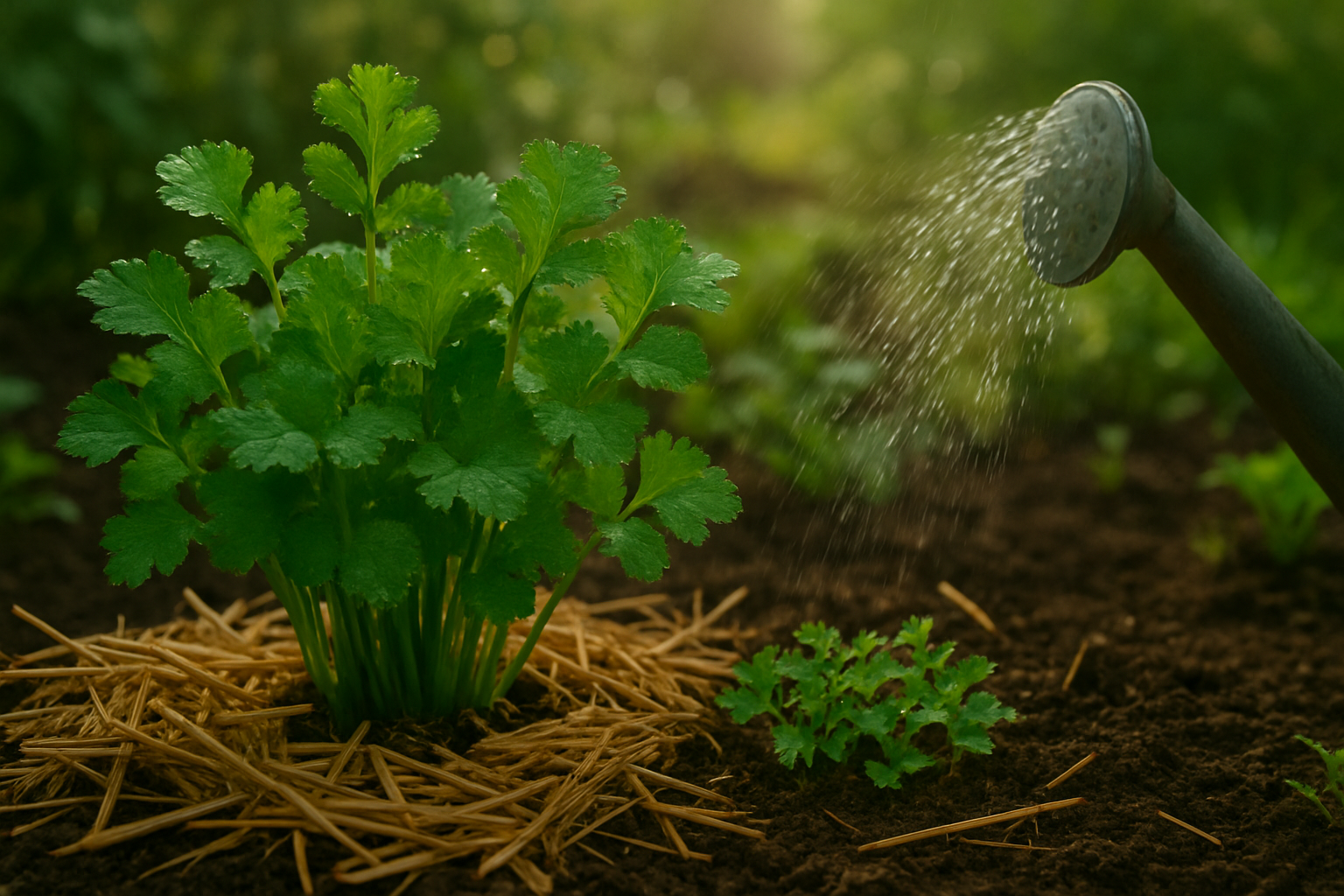
Cilantro is a rewarding herb to grow, but it requires attentive care throughout the season to stay healthy and productive. Water your cilantro plants consistently to keep the soil moist but never soggy. A good rule of thumb is about an inch of water weekly, increasing during hot, dry weather.
Applying a light, organic mulch, such as straw or shredded leaves, helps retain soil moisture and keeps the roots cool—this is especially important since cilantro dislikes heat. For feeding, use a balanced, all-purpose organic fertilizer every few weeks, but avoid over-fertilizing, which can lead to weak, leggy growth.
Preventing Bolting
Cilantro’s biggest challenge is bolting, or going to seed early. You’ll know it’s happening if your plants suddenly shoot up and develop flower stalks—this usually occurs when temperatures rise above 75°F (24°C). To delay bolting:
- Plant cilantro in partial shade during the hottest months
- Keep the soil consistently moist
- Harvest leaves frequently to encourage bushier growth
Pest and Disease Management
When pests strike, aphids and whiteflies are usually the main culprits. You can rinse them off with a strong spray of water or manage them using insecticidal soap. For fungal diseases like powdery mildew, improve air circulation by spacing your plants properly and water at the base to keep foliage dry. Organic remedies such as neem oil work well for both pests and diseases.
Additional Tips
- Crop rotation each season can prevent soil-borne issues.
- If you notice cilantro leaves turning yellow or curling, check for pest infestations or water stress and take action quickly.
With regular attention to these simple maintenance routines and a watchful eye for early signs of trouble, your cilantro will thrive and reward you with lush, fragrant harvests all season long.
Harvesting and Storing Cilantro
Harvesting cilantro at the right time is key to getting the boldest, freshest flavor from your plants. The leaves are most aromatic and tender just before the plant bolts (sends up a flower stalk), usually when they reach 4 to 6 inches tall. Early morning is ideal for harvesting, as leaves are plump and full of moisture. Just snip off the outermost stems using sharp scissors, leaving the inner leaves and center of the plant to keep growing.
For an ongoing harvest, take no more than a third of the plant at once and cut above a growth node; this encourages rapid regrowth. To further extend your cilantro harvest, stagger your plantings every two to three weeks in spring or grow your crop in partial shade as temperatures warm.
After cutting, rinse your cilantro gently and store it in the fridge like a bouquet—stem ends submerged in a jar of water, loosely covered with a plastic bag. For longer storage, you can freeze cilantro by chopping the leaves and freezing them in ice cube trays with a little water. Alternatively, air-dry the seeds (coriander) by letting the plant bolt, then hang cut seed heads upside down in a paper bag until dry.
Whichever storage method you choose, always use airtight containers to preserve maximum freshness. Regular harvesting and proper care ensure you’ll enjoy vibrant cilantro flavor for weeks, whether tossed fresh into salsas, sprinkled on curries, or kept handy in your freezer for winter dishes.
Simple Ways to Use Homegrown Cilantro
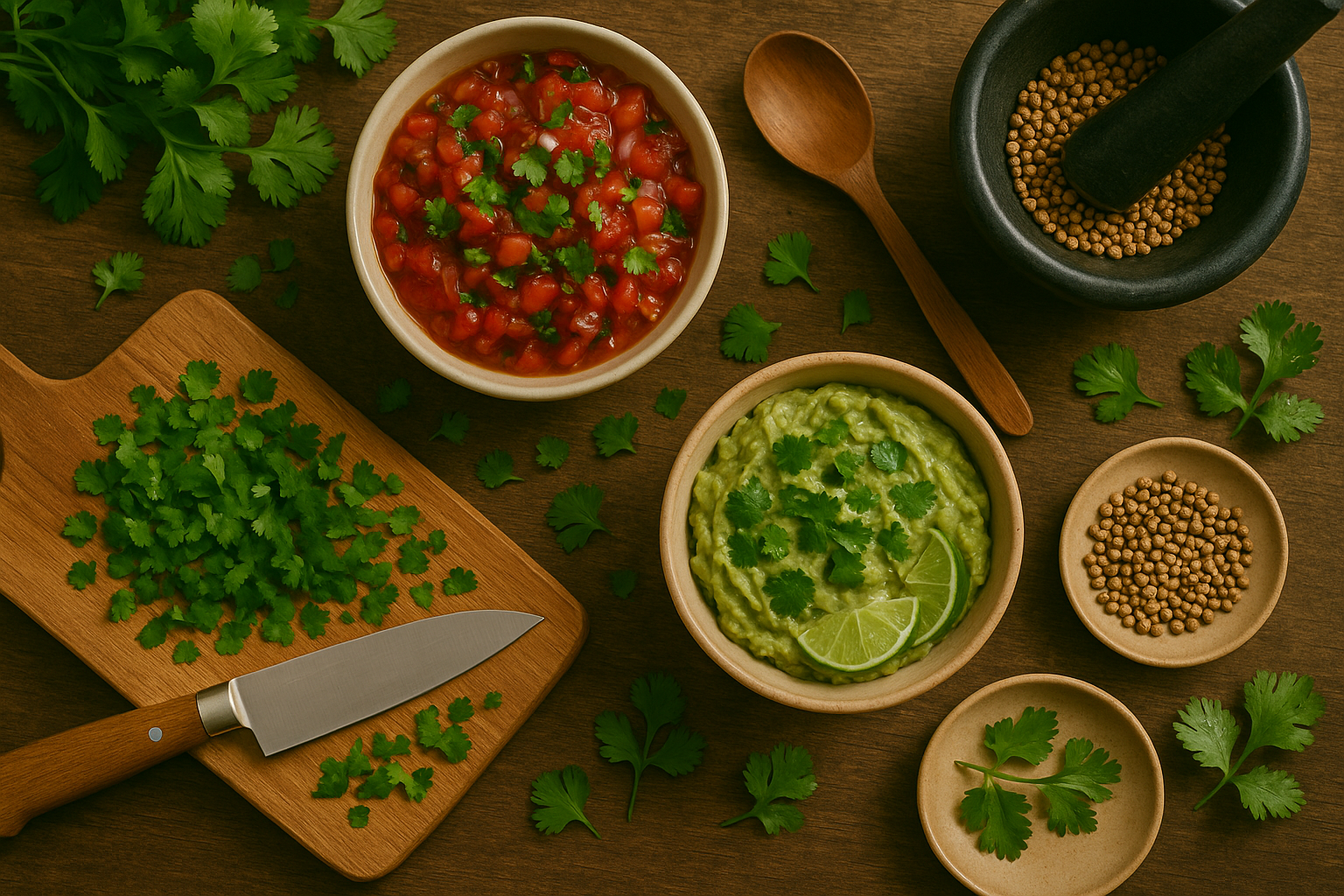
Homegrown cilantro can easily become a kitchen superstar, adding bold flavor to everything from tacos to salads. The fresh leaves are perfect for salsas, guacamole, chutneys, or as a garnish for curries and soups. Try sprinkling chopped cilantro over a bowl of homemade chili or mixing it into a simple tomato and onion salad for a burst of freshness.
Don’t overlook the stems, which can be blended into smoothies or herb sauces for extra green goodness. Cilantro seeds, called coriander, offer a warm, citrusy spice; toast and grind them to season roasted veggies, stir them into bread dough, or add depth to marinades and spice rubs for chicken or fish.
If you find yourself with more cilantro than you can use, freeze the leaves in ice cube trays with olive oil, or make a big batch of cilantro pesto to top grilled veggies or swirl into pasta. Get creative—mix chopped cilantro into scrambled eggs or even homemade pizza. The possibilities are endless when you have a steady supply of this versatile herb right from your own garden.
What’s your favorite way to use up extra cilantro? Share your tips and recipe ideas in the comments below, or send in your questions—let’s grow and cook together as a community!
